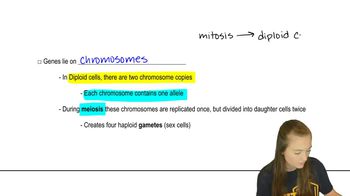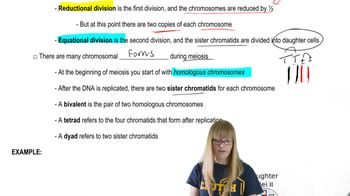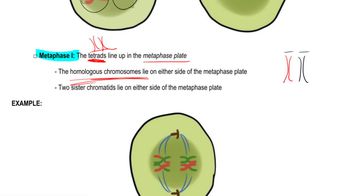Table of contents
- 1. Introduction to Genetics51m
- 2. Mendel's Laws of Inheritance3h 37m
- 3. Extensions to Mendelian Inheritance2h 41m
- 4. Genetic Mapping and Linkage2h 28m
- 5. Genetics of Bacteria and Viruses1h 21m
- 6. Chromosomal Variation1h 48m
- 7. DNA and Chromosome Structure56m
- 8. DNA Replication1h 10m
- 9. Mitosis and Meiosis1h 34m
- 10. Transcription1h 0m
- 11. Translation58m
- 12. Gene Regulation in Prokaryotes1h 19m
- 13. Gene Regulation in Eukaryotes44m
- 14. Genetic Control of Development44m
- 15. Genomes and Genomics1h 50m
- 16. Transposable Elements47m
- 17. Mutation, Repair, and Recombination1h 6m
- 18. Molecular Genetic Tools19m
- 19. Cancer Genetics29m
- 20. Quantitative Genetics1h 26m
- 21. Population Genetics50m
- 22. Evolutionary Genetics29m
9. Mitosis and Meiosis
Meiosis
Problem 5a
Textbook Question
The diploid number of the hypothetical animal Geneticus introductus is 2n = 36. Each diploid nucleus contains 3 ng of DNA in G₁.
Explain why a somatic cell of Geneticus introductus has the same number of chromosomes and the same amount of DNA at the beginning of mitotic prophase as one of these cells does at the beginning of prophase I of meiosis.
 Verified step by step guidance
Verified step by step guidance1
<span>Step 1: Understand the cell cycle phases involved. In both mitosis and meiosis, cells undergo a preparatory phase called interphase, which includes the G₁, S, and G₂ phases. During the S phase, DNA replication occurs, doubling the DNA content while the chromosome number remains the same.</span>
<span>Step 2: Consider the chromosome and DNA content at the beginning of mitotic prophase. After the S phase, each chromosome consists of two sister chromatids, but the number of chromosomes remains the same (2n = 36). The DNA content, however, has doubled to 6 ng.</span>
<span>Step 3: Analyze the chromosome and DNA content at the beginning of prophase I of meiosis. Similar to mitosis, meiosis begins after interphase, where DNA replication has occurred. Thus, at the start of prophase I, each chromosome also consists of two sister chromatids, maintaining the chromosome number at 2n = 36 and the DNA content at 6 ng.</span>
<span>Step 4: Compare the two processes. Both mitotic prophase and prophase I of meiosis start with the same chromosome number and DNA content because they both follow a similar interphase where DNA replication occurs, but no change in chromosome number happens.</span>
<span>Step 5: Conclude the explanation. The key reason for the similarity in chromosome number and DNA content at these stages is the replication of DNA during the S phase of interphase, which precedes both mitosis and meiosis.</span>
Recommended similar problem, with video answer:
 Verified Solution
Verified SolutionThis video solution was recommended by our tutors as helpful for the problem above
Video duration:
1mPlay a video:
Was this helpful?
Key Concepts
Here are the essential concepts you must grasp in order to answer the question correctly.
Diploid Number
The diploid number (2n) refers to the total number of chromosomes in a somatic cell, which in this case is 36 for Geneticus introductus. This means that each somatic cell contains two sets of chromosomes, one inherited from each parent. Understanding the diploid number is crucial for comprehending how genetic information is organized and passed on during cell division.
Recommended video:
Guided course

Diploid Genetics
Mitosis vs. Meiosis
Mitosis is the process of cell division that results in two identical daughter cells, each with the same number of chromosomes as the parent cell. In contrast, meiosis is a specialized form of cell division that reduces the chromosome number by half, producing gametes. At the beginning of mitotic prophase, the somatic cell has the same chromosome number and DNA content as it does at the start of prophase I of meiosis, as both processes begin with diploid cells.
Recommended video:
Guided course

Meiosis Overview
DNA Content in Cell Cycle
The amount of DNA in a cell varies throughout the cell cycle. In the G₁ phase, a diploid cell contains a specific amount of DNA (3 ng in this case), which is duplicated during the S phase, leading to double the DNA content before mitosis or meiosis. However, at the beginning of mitotic prophase and prophase I of meiosis, the DNA content is effectively the same because both processes start with cells that have completed DNA replication.
Recommended video:
Guided course

Bacteriophage Life Cycle

 5:30m
5:30mWatch next
Master Meiosis Overview with a bite sized video explanation from Kylia Goodner
Start learningRelated Videos
Related Practice


